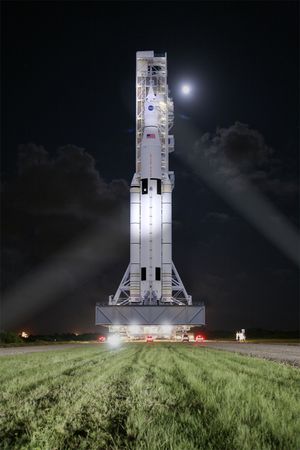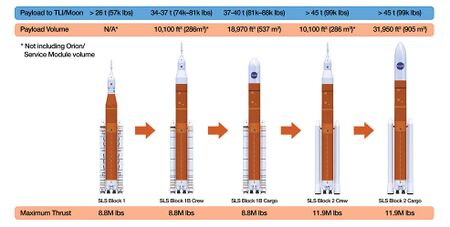نظام الإطلاق الفضائي
 Artist's rendering of the SLS Block 1 crewed variant launching | |
| الوظيفة | مركبة إطلاق |
|---|---|
| Country of origin | الولايات المتحدة |
| التكلفة للإطلاق | 500 مليون دولار أمريكي(2012)[1] |
| Size | |
| Diameter | 8.4 م (المرحلة المحورية) |
| المراحل | 2 |
| Capacity
|حمولة إلى | |
| الصواريخ ذات الصلة | |
| العائلة | مركبات إطلاق مكوكية |
| تاريخ الإطلاق | |
| الحالة | Undergoing development |
| مواقع الإطلاق | إل سي-39، مركز كنيدي الفضائي |
| أول طيران | 17 ديسمبر 2017[2] |
| Type of passengers/cargo | اوريون |
| stage (Block I) | |
| Powered by | 1 |
| Maximum thrust | 3،600،000 lbf (16،000 kN)* |
| Specific impulse | 269 ثانية (2.64 km/s) |
| Burn time | 124 ثانية |
| Propellant | APCP |
| First stage (Block I, IB, II) – Core Stage | |
| Diameter | 8.4 م |
| Empty mass | 85270 كگ |
| Gross mass | 979452 كگ |
| Powered by | 4 RS-25D/E[3] |
| Maximum thrust | 7،440 kN (1،670،000 lbf) |
| Specific impulse | 363 ثانية (3.56 km/s) (مستوى البحر)، 452 ثانية (4.43 km/s) (الفراغ) |
| Propellant | LH2/LOX |
| ثانية stage (Block I) – ICPS | |
| Height | 13.7 م |
| Diameter | 5 م |
| Empty mass | 3490 كگ |
| Gross mass | 30710 كگ |
| Powered by | 1 RL10B-2 |
| Maximum thrust | 110.1 kN (24،800 lbf) |
| Specific impulse | 462 ثانية (4.53 km/s) |
| Burn time | 1125 ثانية |
| Propellant | LH2/LOX |
| ثانية stage (Block IB, Block II) – Exploration Upper Stage | |
| Powered by | 4 RL10 |
| Maximum thrust | 99،000 lbf (440 kN)* |
| Propellant | LH2/LOX |
نظام الإطلاق الفضائي Space Launch System (SLS)، هي مركبة إطلاق فضائي مكوكية ثقيلة أمريكية صممتها ناسا. وتتبع إلغاء برنامج الكوكبة، وجاءت بدلاً من مكوك الفضاء المتقاعد. قانون تفويض ناسا 2010 يتصور تحول تصميمات المركبتين آيرس 1 وآيرس 5 في برنامج الكوكبة إلى مركبة إطلاق فردي يمكن استخدامها للطاقم وللشحن.
Space Launch System (SLS) is an American Space Shuttle-derived super heavy-lift expendable launch vehicle, which has been under development by NASA in the United States since its announcement in 2011. It will be the primary launch vehicle of NASA's deep space exploration plans,[4][5] including the planned crewed lunar flights of the Artemis program and a possible follow-on human mission to Mars.[6][7][8] The SLS program has replaced the Constellation program's Ares V launch vehicle program of 2005, which never left the development phase. SLS is intended to replace the retired Space Shuttle as NASA's flagship vehicle. Following the cancellation of the Constellation program, the NASA Authorization Act of 2010 envisioned a single launch vehicle usable for both crew and cargo. In 2013, SLS was projected to possibly be the most capable super-heavy lift vehicle ever built.[9][10]
The initial variant of SLS, Block 1, was required by the U.S. Congress to lift a payload of 70 t (69 long ton; 77 short ton)[11] to low Earth orbit (LEO), but it was later planned to exceed that requirement with a rated payload capacity of 95 t (93 long ton; 105 short ton).[12] اعتبارا من 22 ديسمبر 2019[تحديث], this variant is planned to launch Artemis 1, Artemis 2, Artemis 3, and Europa Clipper.[13] The later Block 1B is intended to debut the Exploration Upper Stage and launch the notional Artemis 4 through Artemis 7.[14] Block 2 is planned to replace the initial Shuttle-derived boosters with advanced boosters and would have a LEO capability of more than 130 t (130 long ton; 140 short ton), again as required by Congress.[11] Block 2 is intended to enable crewed launches to Mars.[8] SLS is to have the world's highest-ever total LEO payload capability,[15][16] but not the world's highest ever injection mass.[17][18][19] The SLS is planned to launch the Orion spacecraft and use the ground operations and launch facilities at NASA's iconic Kennedy Space Center in Florida. The rocket will use the Launch Complex 39B at the Kennedy Space Center. The rocket's first launch is currently scheduled on November 2021.
وصف المركبة
The SLS is a Space Shuttle-derived launch vehicle, with the first stage of the rocket being powered by one central core stage and two outboard boosters. The upper stage is being developed from the Block 1 variant to a Block 2 variant, the Exploration Upper Stage.
المرحلة المحورية
The Space Launch System's core stage contains the Main Propulsion System (MPS) of the rocket. It is 65 متر (212 ft) long by 8.4 متر (27.6 ft) in diameter and fuels the four RS-25 rocket engines at its base.[20][3][21] The core stage is structurally and visually similar to the Space Shuttle external tank,[9][22] containing the liquid hydrogen fuel and liquid oxygen oxidizer. Initial flights are planned to use modified RS-25D engines left over from the Space Shuttle program.[23] However, Space Shuttle main engines are reusable, so later flights are planned to switch to a different version of the engine not designed for reuse, as it will be cheaper.[24]
The core stage is fabricated at NASA's Michoud Assembly Facility[25] and is common across all currently planned evolutions of the SLS to avoid the need for redesigns to meet varying requirements.[21][26][27][28]
المعززات
معززات الصاروخ الصلب المكوكي
المعززات المتقدمة
المرحلة العليا
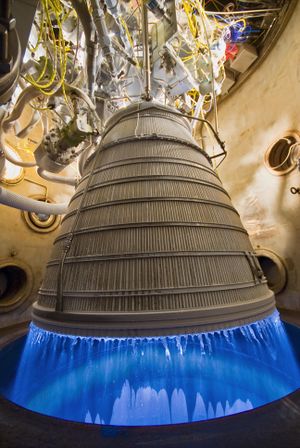
المراحل العليا المؤكدة
المراحل العليا الأخرى
الصاروخ المجمع
تكاليف البرنامج
تاريخ التطوير
تاريخ البرنامج
عمليات الإطلاق
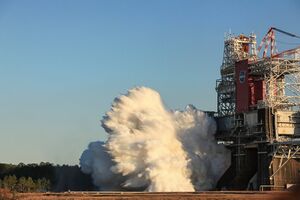
في 16 يناير 2021، تم إيقاف تجربة إشعال محركات نظام إطلاق الفضاء بعد ما يقرب من دقيقة واحدة، مما يعني أن رواد فضاء ناسا عليهم الانتظار لمدة أطول قبل أن يخطون مرة أخرى على سطح القمر.[29]
بعد إنفاق مليارات الدولارت والعمل على المشروع لقرابة عقد، واجه مخطط ناسا لإرسال رواد الفضاء إلى القمر مرة أخرى إنتكاسة يوم السبت، فقد انتهى بصورة مفاجئة بعد دقيقة واحدة فقط اختبار إشعال المحركات الأربعة لصاروخ جديد ضخم مطلوب لرحلات القمر بعد أن كان من المتوقع أن يستمر لثمان دقائق.
وحتى اكتشاف المهندسين سبب العطل، من المحتمل تأجيل إطلاق الصاروخ إلى وقت لاحقا، وهكذا على رواد ناسا للفضاء انتظار مدة أطول قبل أن الصعود إلى سطح القمر مرة أخرى.
على الرغم من ذلك قال مسئولون في ناسا أنه من المبكر للغاية التنبأ بالتأخير إذا كان سيحدث تأخير أصلًا، ويقول جيم بريدنستين مدير وكالة ناسا " لا اعتقد أننا نملك قدر كافي من المعلومات في تلك المرحلة، وهذا يتوقف على مدى الغرابة التي كان عليه الأمر ومدى صعوبة إصلاحه".
أما جون هانيكت، مدير برنامج الصواريخ في ناسا، أنه من المبكر للغاية معرفة إذا ما كان سبب الفشل متعلق بالجهاز أو البرنامج أو جهاز الاستشعار، وأضاف "وهذه أحد الاشياء التي سيقوم بتفقدها داخل البيانات".
كان من المفترض أن تكون تجربة الصاروخ، المعروف باسم نظام إطلاق الفضاء، والذي لم يذهب إلى الفضاء بعد، يوم السبت حدثًا بارزًا؛ فلأول مرة يتم ضبط أربع محركات على منصة الإطلاق ليتم إشعالها لمدة ثمان دقائق، ولذلك لمحاكاة ما سيحدث عن الإطلاق الفعلي.
المركبة هي عنصر أساسي لبرنامج أرتميس، وهو البرنامج المفترض أن يسافر برواد ناسا للفضاء مرة أخرة إلى القمر مرة أخرى. برغم أن الرئيس ترامپ وعد بأن تنطلق الرحلة بحلول نهاية 2024، لا يتوقع الكثيرون أن تتمكن ناسا بالإلتزام بالجدول الزمني.
الصاروخ الذي يتم اختصار اسمه بSLS يعتبر النظير في القرن الواحد والعشرين لصاروخ ساترن ڤي الذي سافر برواد ناسا إلى القمر في ستينيات القرن العشرين وسبعيناته. وبرغم وجود العديد من الصواريخ في الوقت الحالي، لكن أحجامهم صغيرة للغاية لإطلاق سفن فضائية تحمل أفراد إلى القمر. (هناك استثناء محتمل وهو صاروخ فالكون هڤي أو الصقر الثقيل، لكنه يحتاج إلى عمليتين إطلاق لإرسال رحلة على متنها أشخاص إلى القمر.)
الإصدار الأول من SLS قادر على حمل 70 طن متر، وسيكون الإصدار المسقبلي قادر على حمل 130 طن متر أي أن قدرته على الحمل ستتعدى قدرة الصواريخ التي حملت رواد أبولو.
وبرغم أن نظام إطلاق الفضاء سيكون مكلف للغاية- قد تصل التكلفة إلى مليارين لإطلاق صاروخ سيتم استخدامه مرة واحدة- قدم الكونگرس له تمويلًا ثابتًا حتى الآن. يؤكد مؤيدوه أنه من المهم للحكومة ن تقوم بإمتلاك صاروخ قوي للسفر في أعماق الفضاء وتشغيله أيضًا بالإضافة أجزاء من النظام تقوم عدة شركات في جيمع أنحاءالبلاد بتصنيعها، منأج توزيع الفوائد الاقصادية على عدة ولايات ودوائر برلمانية.
معزز الصاروخ المستخدم في تجربة يوم السب كان من المقرر أن ينطلق إلى الفضاء في نوفمبر في رحلة تجربية خالية من الركاب، تحت اسم أرتميس 1، وكان من المفترض أن يحمل كبسولة ستدور حول القمر وتعود، ولكن بدلًا من تجهيز معزز الصاروخ لشحنه إلى مركز ككيدي للفضاء في فلوريدا، يسحاول المهندسون أولًا التحقيق في العطل.
لم يكن من المخطط أن يذهب المعزز إلى أي مكان يوم السبت فقد كان مثبت إلى الأرض بشدة أثناء إجراء التجربة في مركز ستنيس للفضاء في ميسيسيپي.
بعد العديد من التحولات أثناء الاختبار، بدأ تشغيل المحركات بشكل طبيعي في تمام 5:27 مساء بتوقيت المنطقة الزمنية الشرقية، بدء سحب بيضاء بالظهور من منصة الإختبار، ولكن بعد خولي 50 ثانية من التشغيل قال أحد المراقبين "هناك إخفاق في أحد العناصر الأساسية".
ورد مسئول الاختبار: "سجل ذلك، لكن سنكمل، فمايزال لدينا أربعة محركات سليمة، أليس كذلك ؟"
ولكن ظهر وميض حول المعرك الذي كان يعاني من إخفاق، وقام البرنامج الآلي في الصاروخ بإيقاف جميع المحركات.
وبرغم أن الصاروخ جديد، لكن المحركات كانت قديمة، فهي نفس المحركات التي كانت تطيلر إلى المدار على مكوكات الفضاء التابعة لوكالة ناسا؛ فقد تم تجديد المحركات الأساسية لمكوك الفضاء وتطويرها وتغيير اسها إلى: RS-25.
بعد أن تم بناء منصة معزز الصاروخ في مرفق جميعة ميتشود في نيو أورليانز التابعة لناسا، قاموا ببيعخا إلى ستنيز وتم وضعها فوق منصة الاختبار التي تم استخدامها في ستينيات القرن العشرين لاختبار المنصة الأولى لساترن ڤي.
بدء حينها المهندسون عدة اختبارت التي أطلقت عليها ناسا اسم گرين رن، لتقييم أنظمة الصواريخ، كان من المفترض أن يكون اختبار إشعال السبت ختام لگرين رن، وكان من المفترض ان يستمر لثمان دقائق وعشر ثواني.
قال جون شانون، مدير نظام إطلاق الصورايه في بوينگ التي قامت ببناء المعزز، في مؤتمر إعلان عن البرنامج يوم الثلاثاء، أن المهندسين سيجمعون جميع البينات الخاصة بالهندسة التي سيحتاجونها بعد حوال 250 ثانية، لكن اختبار يوم السبت اسمر فقط 80 ثانية.
قبل نقل المعزز لتنيس، قرر مسئولو ناسا التخلي عن گرين رن من أملًا في إنطلاق رحلة أرميتس 1 إلى القمر في وقت أقرب. عندما اعلنت ناسا لأول مرة عن خططتها بشأن S.L.S في 2011، كانت تأمل في إطلاق أول رحلة تجريبة بدون طاقم في 2017، وبسبب الإخفاقات الأخير لن يتم تم إجراء عملية الإطلاق في الغالب قبل عام 2022 على الأقل.
وإذا توقفت المحركات كما حدث في عملية إطلاق أرميتس 1 كما حدث يوم السبت، فلن يقدر الصاروخ في الغالب على الدوران، وستبوء المهمة بالفشل.
منافسته لمركبة الإطلاق الرافع الثقيلة الأمريكية
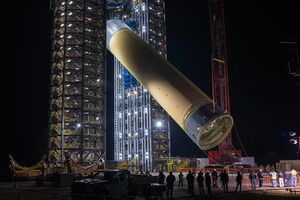
نقد
المهمات المقترحة والجدول الزمني
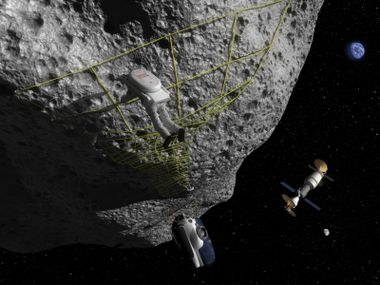
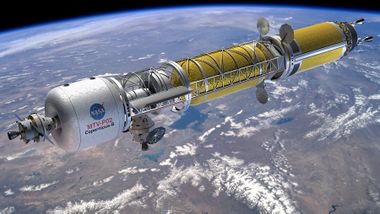
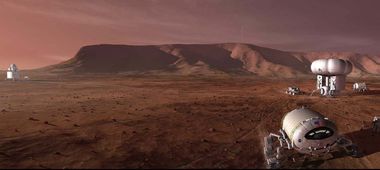
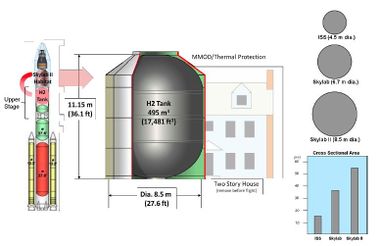
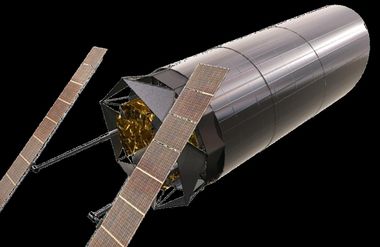
| المهمة | التاريخ المستهدف | المتغير | هوامش |
|---|---|---|---|
| SLS-1/EM-1 | نوفمبر 2018[32] | Block I[33] | Send uncrewed Orion/MPCV on trip around the Moon. |
| SLS-2/EM-2 | 2021[34] | Block IB[35] | Send the Orion (spacecraft) with four members to an asteroid that had been robotically captured and placed in lunar orbit two years in advance.[36] |
| SLS-3 | أغسطس 2022[37] | Block IA[33] | |
| SLS-4 | أغسطس 2023[37] | Block IA[33] | |
| SLS-5 | أغسطس 2024[37] | Block IA[37] | Mars Sample Return Mission[38] |
| SLS-6 | أغسطس 2025[37] | Block IA[37] | Crewed "Exploration" Mission: Orion BEO picks up Mars sample & returns to Earth |
| SLS-7 | أغسطس 2026[37] | Block IA[37] | إطلاق شحن |
| SLS-8 | أغسطس 2027[37] | Block IA[37] | إطلاق مأهول |
| SLS-9 | أغسطس 2028[37] | Block IA[37] | إطلاق شحن |
| SLS-10 | أغسطس 2029[37] | Block IA[37] | إطلاق مأهول |
| SLS-11 | أغسطس 2030[37] | Block IA[37] | تكوين جديد، إطلاق شحن |
| SLS-12 | أغسطس 2031[37] | Block IA[37] | مهمة مأهولة |
| SLS-13 | أغسطس 2032[37] | Block II[37] | تكوين جديد، إطلاق شحن |
معرض صور
RS-25D engine testing at Stennis Space Center.
انظر أيضاً
- آرس 5 - مركبة شحن مصممة من أجل برنامج الكوكبة في عقد 2000.
- مقارنة عائلات الإطلاق المداري
- مقارنة نظم الإطلاق الفضائي
- دايركت - منافس آرس 5، لكنها ذات قدرة حمولة أقل، تعتمد على صواريخ جوپيتر.
- إنرجيا - مركبة مقارنة للبلوك 1 بنظام الإطلاق القفضائي من أجل رحلات المدار المنخفض للأرض
- استكشاف المريخ
- المهمة المأهولة للمريخ
- مركبة مورفيوس - مركبة إبرار صاروخية تعمل بالطاقة الصاروخية مصممة لاستخدام الوقود الدافع المصنوع على سطح المريخ.
- نوتيلوس-10 - وحدة مقترحة كمأوى في الفضاء العميق.
- Saturn MLV - صاروخ رفع ثقيل معدل للصاروخ ساترن 5 من الستينيات، تم تصميمه لمهمات المريخ بحلول الثمانينيات.
- Saturn V ELV - تصميم ساترن 5 المعدل، مع strapon Titan IV solid rocket boosters.
- Saturn V-3 - upgraded Saturn V design concept of 1960s, using F-1A 1st stage engines/HG-3 2nd stage engines.
- Shuttle-Derived Heavy Lift Launch Vehicle - concept vehicle with a lower lift capability than Saturn V.
- مركبة استكشاف الفضاء
- سياسة الفضاء في عهد باراك أوباما
- مركبات تالية لمكوك الفضاء
مرئيات
| فشل إطلاق مركبة SLS التابعة لناسا، مركز ستنس الفضائي، مسيسپي، 16 يناير 2021. |
المصادر
- ^ "NASA's huge new rocket may cost $500 million per launch". MSNBC. September 12, 2012.
- ^ "Space Launch System: How to launch NASA's new monster rocket". NASASpaceFlight.com. 20 February 2012. Retrieved 9 April 2012.
- ^ أ ب "space launch system" (PDF). nasa.gov. 2012. Archived from the original (PDF) on 2012-08-13.
 هذا المقال يضم نصاً من هذا المصدر، الذي هو مشاع.
هذا المقال يضم نصاً من هذا المصدر، الذي هو مشاع.
- ^ Siceloff, Steven (April 12, 2015). "SLS Carries Deep Space Potential". nasa.gov. Retrieved 2 January 2018.
 هذا المقال يضم نصاً من هذا المصدر، الذي هو مشاع.
هذا المقال يضم نصاً من هذا المصدر، الذي هو مشاع.
- ^ "World's Most Powerful Deep Space Rocket Set To Launch In 2018". iflscience.com. Retrieved 2 January 2018.
- ^ Chiles, James R. "Bigger Than Saturn, Bound for Deep Space". airspacemag.com. Retrieved 2 January 2018.
- ^ "Finally, some details about how NASA actually plans to get to Mars". arstechnica.com. Retrieved 2 January 2018.
- ^ أ ب Gebhardt, Chris (April 6, 2017). "NASA finally sets goals, missions for SLS – eyes multi-step plan to Mars". NASASpaceFlight.com. Retrieved August 21, 2017.
- ^ أ ب Stephen Clark (March 31, 2011). "NASA to set exploration architecture this summer". Spaceflight Now. Retrieved 26 May 2011.
- ^ Dwayne Day (November 25, 2013). "Burning thunder".
- ^ أ ب خطأ استشهاد: وسم
<ref>غير صحيح؛ لا نص تم توفيره للمراجع المسماةAuthAct10 - ^ Harbaugh, Jennifer (2 May 2018). "The Great Escape: SLS Provides Power for Missions to the Moon". nasa.gov. NASA. Retrieved 22 December 2019.
 هذا المقال يضم نصاً من هذا المصدر، الذي هو مشاع.
هذا المقال يضم نصاً من هذا المصدر، الذي هو مشاع.
- ^ Gebhardt, Chris (15 August 2019). "Eastern Range updates 'Drive to 48' launches per year status". NASASpaceflight.com. Retrieved 6 January 2020.
NASA, on the other hand, will have to add this capability to their SLS rocket, and Mr. Rosati said NASA is tracking that debut for the Artemis 3 mission in 2023.
- ^ "Space Launch System". aerospaceguide.net.
- ^ Harbaugh, Jennifer (May 12, 2017). "NASA Continues Testing, Manufacturing World's Most Powerful Rocket". nasa.gov.
 هذا المقال يضم نصاً من هذا المصدر، الذي هو مشاع.
هذا المقال يضم نصاً من هذا المصدر، الذي هو مشاع.
- ^ Wall, Mike (August 16, 2016). "Yes, NASA's New Megarocket Will Be More Powerful Than the Saturn V". Space.com. Retrieved September 13, 2018.
- ^ The Congress of the United States. Congressional Budget Office, October 2006, pp. X,1,4,9. "The Apollo Saturn V launch vehicle had a lift capability of 140 metric tons to low Earth orbit"
 هذا المقال يضم نصاً من هذا المصدر، الذي هو مشاع.
هذا المقال يضم نصاً من هذا المصدر، الذي هو مشاع.
- ^ Wells, Jane (January 26, 2016). "Boeing builds the most powerful rocket ever made". cnbc.com.
- ^ Wood, Anthony (July 25, 2015). "Most powerful rocket ever edges closer to lift-off". New Atlas. Retrieved September 13, 2018.
- ^ Harbaugh, Jennifer (2019-12-09). "NASA, Public Marks Assembly of SLS Stage with Artemis Day". nasa.gov. NASA. Retrieved 2019-12-10.
NASA and the Michoud team will shortly send the first fully assembled, 212-foot-tall core stage...27.6-feet-in-diameter tanks and barrels.
 هذا المقال يضم نصاً من هذا المصدر، الذي هو مشاع.
هذا المقال يضم نصاً من هذا المصدر، الذي هو مشاع.
- ^ أ ب خطأ استشهاد: وسم
<ref>غير صحيح؛ لا نص تم توفيره للمراجع المسماةNSFTrades - ^ Chris Bergin (14 September 2011). "SLS finally announced by NASA – Forward path taking shape". NASASpaceFlight.com. Retrieved 26 January 2012.
- ^ Sloss, Philip. "NASA ready to power up the RS-25 engines for SLS". NASASpaceFlight.com. Retrieved 2015-03-10.
- ^ خطأ استشهاد: وسم
<ref>غير صحيح؛ لا نص تم توفيره للمراجع المسماةNSFStennis012015 - ^ "NASA's Space Launch System Core Stage Passes Major Milestone, Ready to Start Construction". Space Travel. 27 December 2012.
- ^ Chris Bergin (April 25, 2011). "SLS planning focuses on dual phase approach opening with SD HLV". NASASpaceFlight.com. Retrieved January 26, 2012.
- ^ Bergin, Chris (June 16, 2011). "Managers SLS announcement after SD HLV victory". NASASpaceFlight.com. Retrieved January 26, 2012.
- ^ Bergin, Chris (23 February 2012). "Acronyms to Ascent – SLS managers create development milestone roadmap". NASASpaceFlight.com. Retrieved 9 April 2012.
- ^ "NASA's Mega Rocket to the Moon Faces Setback After Test". نيويورك تايمز. 2021-01-16. Retrieved 2021-01-17.
- ^ "SMALL PRESSURIZED ROBOT (CHARIOT WITH A CABIN)".
- ^ "Human Exploration of Mars Design Reference Architecture 5.0 2009" (PDF).
- ^ http://www.nasa.gov/press/2014/august/nasa-completes-key-review-of-world-s-most-powerful-rocket-in-support-of-journey-to/#.U_5UAfl7Eeg
- ^ أ ب ت خطأ استشهاد: وسم
<ref>غير صحيح؛ لا نص تم توفيره للمراجع المسماةnasaspaceflight2 - ^ "Orion's First Test Flight Offers Space Launch System a First Look at Hardware Operation, Integration". NASA. June 29, 2012. Retrieved December 11, 2012.
- ^ خطأ استشهاد: وسم
<ref>غير صحيح؛ لا نص تم توفيره للمراجع المسماةNSFEUS - ^ خطأ استشهاد: وسم
<ref>غير صحيح؛ لا نص تم توفيره للمراجع المسماةReferenceA - ^ أ ب ت ث ج ح خ د ذ ر ز س ش ص ض ط ظ ع غ ف خطأ استشهاد: وسم
<ref>غير صحيح؛ لا نص تم توفيره للمراجع المسماةWorstCase - ^ خطأ استشهاد: وسم
<ref>غير صحيح؛ لا نص تم توفيره للمراجع المسماة2024 MSR
وصلات خارجية
- Convert invalid options
- Pages using infobox rocket with unknown parameters
- مقالات فيها عبارات متقادمة منذ ديسمبر 2019
- جميع المقالات التي فيها عبارات متقادمة
- Pages with empty portal template
- أنظمة إطلاق قابلة لإعادة الاستخدام
- مركبات فضائية تابعة لناسا
- مركبات إطلاق فضائي مقترحة
- نظام الإطلاق الفضائي
- برنامج اوريون
